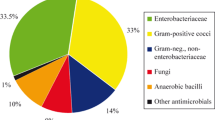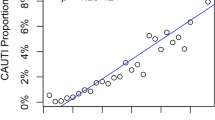Abstract
Purpose
Our purpose is to present the results of our working group, with a view to reduce the incidence and improve the management of healthcare-associated infections (HAIs) in a urology ward.
Methods
The study consists on an observational database designed with the view to analyse the incidence and characteristics of HAIs in Urology. Based on the results obtained, a critical evaluation was carried out and specific measures put in place to reduce HAIs. Finally, the impact and results of the implemented measures were periodically evaluated.
Results
The incidence of HAIs in urology decreased from 6.6 to 7.3% in 2012–2014 to 5.4–5.8% in 2016–2018. In patients with immunosuppression the incidence of HAIs decreased from 12.8 to 18% in 2012–2013 to 8.1–10.2% in 2017–2018, in those with a previous urinary infection fell from 13.6 to 4.8%, in those with a urinary catheter prior to admission from 12.6 to 10.8%, and in patients with a nephrostomy tube from 16 to 10.9%. The effect of the protocol also demonstrated a reduction in the percentage of patients with suspicion of HAIs for whom no culture was taken, from 6% in 2012 to zero in 2017 and 2018. Moreover, the implementation of protocols for empirical treatment has reduced the incidence of patients experiencing inadequate empirical antimicrobial therapy from 20 to 8.1%.
Conclusion
It is essential to monitor the incidence of HAIs, and preventive measures play a useful role in reducing the rate of infection and in optimising their management.


Similar content being viewed by others
References
Trinchieri A, Paparella S, Cappoli S et al (2009) Prospective assessment of the efficacy of the EAU guidelines for the prevention of nosocomial acquired infections after genitourinary surgery in a district hospital. Arch Ital Urol Androl 81:46–50
Doyle B, Mawji Z, Horgan M et al (2001) Decreasing nosocomial urinary tract infection in a large academic community hospital. Lippincotts Case Manag Manag Process Patient Care 6:127–136
Spoorenberg V, Hulscher MEJL, Akkermans RP et al (2014) Appropriate antibiotic use for patients with urinary tract infections reduces length of hospital stay. Clin Infect Dis 58:164–169. https://doi.org/10.1093/cid/cit688
Haley RW, Culver DH, White JW et al (1985) The efficacy of infection surveillance and control programs in preventing nosocomial infections in US hospitals. Am J Epidemiol 121:182–205
Gross PA (2006) Hypotension and mortality in septic shock: the “golden hour”. Crit Care Med 34:1819–1820. https://doi.org/10.1097/01.CCM.0000220054.95214.7D
Hamasuna R, Takahashi S, Yamamoto S et al (2011) Guideline for the prevention of health care-associated infection in urological practice in Japan. Int J Urol 18:495–502. https://doi.org/10.1111/j.1442-2042.2011.02769.x
Global Alliance for Infections in Surgery Working Group (2017) A global declaration on appropriate use of antimicrobial agents across the surgical pathway. Surg Infect 18:846–853. https://doi.org/10.1089/sur.2017.219
Horan TC, Andrus M, Dudeck MA (2008) CDC/NHSN surveillance definition of health care-associated infection and criteria for specific types of infections in the acute care setting. Am J Infect Control 36:309–332. https://doi.org/10.1016/j.ajic.2008.03.002
Johansen TEB (2004) Nosocomially acquired urinary tract infections in Urology Departments. Why an international prevalence study is needed in urology. Int J Antimicrob Agents 23(Suppl 1):S30–S34. https://doi.org/10.1016/j.ijantimicag.2003.09.003
Lo E, Nicolle LE, Coffin SE et al (2014) Strategies to prevent catheter-associated urinary tract infections in acute care hospitals: 2014 update. Infect Control Hosp Epidemiol 35:464–479. https://doi.org/10.1086/675718
Anderson DJ, Podgorny K, Berríos-Torres SI et al (2014) Strategies to prevent surgical site infections in acute care hospitals: 2014 update. Infect Control Hosp Epidemiol 35(Suppl 2):S66–S88
Hedrick TL, Sawyer RG (2005) Health-care-associated infections and prevention. Surg Clin North Am 85(1137–1152):ix. https://doi.org/10.1016/j.suc.2005.09.013
Medina-Polo J, Sopeña-Sutil R, Benítez-Sala R et al (2017) Prospective study analyzing risk factors and characteristics of healthcare-associated infections in a urology ward. Investig Clin Urol 58:61–69. https://doi.org/10.4111/icu.2017.58.1.61
Medina-Polo J, Jiménez-Alcaide E, García-González L et al (2014) Healthcare-associated infections in a department of Urology: incidence and patterns of antibiotic resistance. Scand J Urol 48:203–209. https://doi.org/10.3109/21681805.2013.834512
Grabe M, Botto H, Cek M et al (2012) Preoperative assessment of the patient and risk factors for infectious complications and tentative classification of surgical field contamination of urological procedures. World J Urol 30:39–50. https://doi.org/10.1007/s00345-011-0722-z
Cai T, Verze P, Brugnolli A et al (2016) Adherence to European Association of Urology guidelines on prophylactic antibiotics: an important step in antimicrobial stewardship. Eur Urol 69:276–283. https://doi.org/10.1016/j.eururo.2015.05.010
DasGupta R, Sullivan R, French G, O’Brien T (2009) Evidence-based prescription of antibiotics in urology: a 5-year review of microbiology. BJU Int 104:760–764. https://doi.org/10.1111/j.1464-410X.2009.08779.x
Wagenlehner FME, Cek M, Naber KG et al (2012) Epidemiology, treatment and prevention of healthcare-associated urinary tract infections. World J Urol 30:59–67. https://doi.org/10.1007/s00345-011-0757-1
Wagenlehner FME, Naber KG (2004) Emergence of antibiotic resistance and prudent use of antibiotic therapy in nosocomially acquired urinary tract infections. Int J Antimicrob Agents 23(Suppl 1):S24–S29. https://doi.org/10.1016/j.ijantimicag.2003.09.004
Tenke P, Kovacs B, Bjerklund Johansen TE et al (2008) European and Asian guidelines on management and prevention of catheter-associated urinary tract infections. Int J Antimicrob Agents 31(Suppl 1):S68–S78. https://doi.org/10.1016/j.ijantimicag.2007.07.033
Gastmeier P (2001) Nosocomial urinary tract infections: many unresolved questions. Clin Microbiol Infect 7:521–522
Jain P, Parada JP, David A, Smith LG (1995) Overuse of the indwelling urinary tract catheter in hospitalized medical patients. Arch Intern Med 155:1425–1429
Shokeir AA, Al Ansari AA (2006) Iatrogenic infections in urological practice: concepts of pathogenesis, prevention and management. Scand J Urol Nephrol 40:89–97. https://doi.org/10.1080/00365590510031093
Lara-Isla A, Medina-Polo J, Alonso-Isa M et al (2017) Urinary infections in patients with catheters in the upper urinary tract: Microbiological Study. Urol Int 98:442–448. https://doi.org/10.1159/000467398
Gili-Ortiz E, González-Guerrero R, Béjar-Prado L et al (2015) Surgical site infections in patients who undergo radical cystectomy: excess mortality, stay prolongation and hospital cost overruns. Actas Urol Esp 39:210–216. https://doi.org/10.1016/j.acuro.2014.11.004
Kyoda Y, Takahashi S, Takeyama K et al (2010) Decrease in incidence of surgical site infections in contemporary series of patients with radical cystectomy. J Infect Chemother 16:118–122. https://doi.org/10.1007/s10156-010-0032-1
Tenke P, Köves B, Johansen TEB (2014) An update on prevention and treatment of catheter-associated urinary tract infections. Curr Opin Infect Dis 27:102–107. https://doi.org/10.1097/QCO.0000000000000031
Tandoğdu Z, Bartoletti R, Cai T et al (2016) Antimicrobial resistance in urosepsis: outcomes from the multinational, multicenter global prevalence of infections in urology (GPIU) study 2003–2013. World J Urol 34:1193–1200. https://doi.org/10.1007/s00345-015-1722-1
Acknowledgements
We acknowledge the effort and collaboration to all personnel of the department of Urology for preventing infections. Moreover, special thanks for all the residents of our department who have actively collected and reviewed the data.
Author information
Authors and Affiliations
Contributions
JM-P: project development, data collection or management, data analysis, and manuscript writing/editing. JG-M: data collection or management, data analysis, and manuscript writing/editing. JJ-Q: data collection or management, data analysis, and manuscript writing/editing. DAG-P: data collection or management, data analysis, and manuscript writing/editing. EG-R: data collection or management, data analysis, and manuscript writing/editing. AG-D: data collection or management, data analysis, and manuscript writing/editing. PA-L: data collection or management, and manuscript writing/editing. MH-A: data collection or management, and manuscript writing/editing. RS-PB: data collection or management manuscript writing/editing. HP-V: data collection or management and manuscript writing/editing. JT-T: data collection or management and manuscript writing/editing. FLM: data analysis and manuscript writing/editing. ÁT-S: project development, data analysis, and manuscript writing/editing.
Corresponding author
Ethics declarations
Ethical approval
All procedures performed in studies involving human participants were in accordance with the ethical standards of the institutional and/or national research committee and with the 1964 Helsinki Declaration and its later amendments or comparable ethical standards.
Informed consent
The prospective observational study did not affect the daily clinical practice. Therefore, additional informed consent was not required the patients included in the registry.
Additional information
Publisher's Note
Springer Nature remains neutral with regard to jurisdictional claims in published maps and institutional affiliations.
Rights and permissions
About this article
Cite this article
Medina-Polo, J., Gil-Moradillo, J., Justo-Quintas, J. et al. Prevention of healthcare-associated infections (HAIs) in a surgical urology ward: observational study—analysis of the problem and strategies for implementation. World J Urol 38, 3–8 (2020). https://doi.org/10.1007/s00345-019-02648-3
Received:
Accepted:
Published:
Issue Date:
DOI: https://doi.org/10.1007/s00345-019-02648-3




